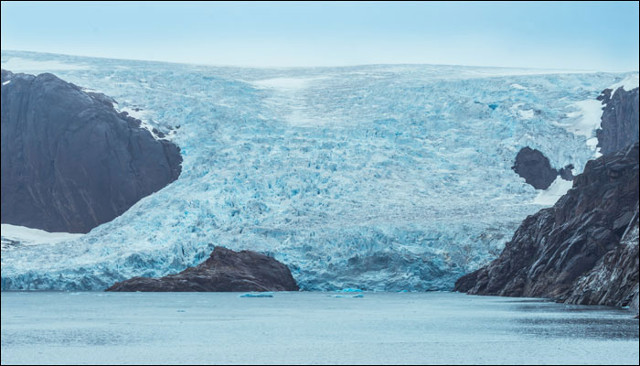Why are the Antarctic glaciers in France interested in by scientists?
A huge French glacier floating in the Antarctic waters has raised scientists' concerns, revealing that this river's ice volume is moving more than anticipated. there.
Scientists are concerned that glaciers may melt faster when the climate warms up and there is a significant impact on rising sea levels.
One of the largest and fastest-flowing glaciers in Antarctica named Totten Glacier, is capable of releasing huge amounts of water and scientists are interested in the melting pattern of this river.
Using seismic waves to help scientists see through the ice, researchers have discovered that more Totten Glacier tidal currents appear floating on the ocean than originally expected.

Paul Winberry from Central Washington University spent the summer in Antarctica to study Totten saying: "In some locations, we think there is ground, we have found that this glacier is in a state floating pretty much ice blocks are melting. "
This finding is important because recent studies show that the sub-continental shelf of the River Totten Glacier has been eroded by warm, salty seawater that flows from hundreds of kilometers into the mainland after they pass through the "door. lane "under water.
Winberry said more about this floating glacier ocean is heating up that could help explain its recent melting periods.
He added: "This also means that the Totten River may be more sensitive to future climate change."
Glaciers often form when dense ice sheets move from above to the valleys, mountains and slopes depending on their weight for centuries, moving on the surface of the earth.
They keep most of the earth's fresh water and make a major contribution to the rising sea level as they melt.
According to NASA's supervisor, between 2002 and 2016, Antarctica took 125 gigatons of ice a year, making the world sea level rise 0.35 millimeters per year.
From the air, the contours of the river Totten Glacier are invisible because the entire Antarctic continent is covered with a dense layer of snow and ice.
That's why scientists are determined to find out what's going on under the hidden glacier.
Head of the South Pole Division, Ben Galton-Fenzi, said that the Totten Glacier contained enough ice to make the sea level rise about three meters (9.8 feet) if all melted.
"Since the 1900s, global sea levels have risen by about 20 cm and by the end of the century, the forecast will rise to one meter or more, but this is uncertain so that is why research Glaciers like Totten are very important, "he said.
You should read it
- Hot winds are weakening Antarctic ice sheets
- Is the Antarctic once covered by lush subtropical forests?
- The 'fairy' world in the ice cave is 12,000 meters deep
- The 'Blood Falls' in Antarctica, hundreds of years of mystery has been decoded
- Germany used to be covered by 450,000 years ago
- Invite to admire the series of ultra-unique dual screen laptop of the big guys in the technology village
- How to adjust the iPhone Control Center interface
- There are signs of ecological change due to climate change in the arid valley of Antarctica
May be interested
- Germany and France break through in developing MGCS tanks 'stronger than Armata'
 germany and france have signed a 'groundbreaking agreement' on the development of a new generation european tank - mgcs, which is expected to replace the leopard 2 and leclerc.
germany and france have signed a 'groundbreaking agreement' on the development of a new generation european tank - mgcs, which is expected to replace the leopard 2 and leclerc. - Visit the 4 best restaurants in Lyon, France
 not only is france's third-largest city, it also owns a variety of delicious quality gourmet restaurants, which are the 4 most typical restaurants.
not only is france's third-largest city, it also owns a variety of delicious quality gourmet restaurants, which are the 4 most typical restaurants. - 8 most beautiful nature photos of November voted by National Geographic
 the foggy image that surrounds the rocky outcrops of basque, the flock of flamingos in the lake, the cave inside the vatnajökull glacier or the arctic snow fox ... are some of the most beautiful natural images by the site. national geographic voted in november.
the foggy image that surrounds the rocky outcrops of basque, the flock of flamingos in the lake, the cave inside the vatnajökull glacier or the arctic snow fox ... are some of the most beautiful natural images by the site. national geographic voted in november. - Telegram said the CEO has 'nothing to hide' after being arrested in France
 telegram said ceo and founder pavel durov has nothing to hide after being arrested in france.
telegram said ceo and founder pavel durov has nothing to hide after being arrested in france. - France successfully tested anti-malarial drugs combined with antibiotics to treat Covid-19
 an effective treatment of covid-19 has been reported by the french and vietnamese scientists in the international journal of antimicrobial agents, where they tested two hydroxychloroquine drugs (trade name is plaquenil). , which is used to treat malaria) and azithr
an effective treatment of covid-19 has been reported by the french and vietnamese scientists in the international journal of antimicrobial agents, where they tested two hydroxychloroquine drugs (trade name is plaquenil). , which is used to treat malaria) and azithr - Scientists are increasingly interested in warp engines, which 'space distortion' technology allows us to travel at the s
 warp engines - the strange thing is that this motive is possible and doesn't seem to violate physical rules.
warp engines - the strange thing is that this motive is possible and doesn't seem to violate physical rules. - NASA will prioritize the recruitment of experienced scientists in blockchain and cryptocurrency
 nasa is becoming increasingly interested in the field of blockchain.
nasa is becoming increasingly interested in the field of blockchain. - Google paid a fine of 50 million euros after allegedly violating the General Data Protection Act in France
 france's data protection administration, cnil, yesterday decided to issue a fine of up to 50 million euros (about 56.8 million us dollars) to google for failing to comply with the provisions of the law on security. general data protection (gdpr).
france's data protection administration, cnil, yesterday decided to issue a fine of up to 50 million euros (about 56.8 million us dollars) to google for failing to comply with the provisions of the law on security. general data protection (gdpr). - NASA captures a large, square-shaped piece of ice
 but not because aliens make it.
but not because aliens make it. - Germany used to be covered by 450,000 years ago
 the new study shows that germany was covered by glaciers 450,000 years ago, and the earliest human settlers came when the glacier retreated about 400,000 years ago.
the new study shows that germany was covered by glaciers 450,000 years ago, and the earliest human settlers came when the glacier retreated about 400,000 years ago.










 Land degradation threatens millions of people in the future
Land degradation threatens millions of people in the future Half of the wild animals of large forests may disappear as the planet heats up
Half of the wild animals of large forests may disappear as the planet heats up A global temperature increase of only half a degree may cause 5 million people to lose their homes
A global temperature increase of only half a degree may cause 5 million people to lose their homes These 13 cities may increase by more than 2 degrees Celsius by 2020
These 13 cities may increase by more than 2 degrees Celsius by 2020 The researchers turned CO into CO2 with a single metal atom
The researchers turned CO into CO2 with a single metal atom How are people using plastic to destroy nature?
How are people using plastic to destroy nature?